.
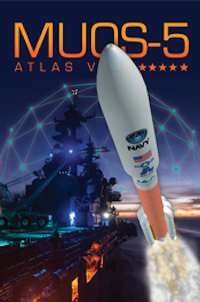
Atlas V to Launch the Fifth Mobile User Objective System (MUOS-5)
Atlas V MUOS-5 Mission ArtworkRocket/Payload: An Atlas V 551 will launch the U.S. Navy’s fifth Mobile User Objective System (MUOS-5) satellite, built by Lockheed Martin.
Date/Site/Launch Time: No earlier thanThursday, May 12, from Space Launch Complex-41 at Cape Canaveral Air Force Station, Florida.
Mission Description: The fifth Mobile User Objective System (MUOS-5) satellite is the latest addition to a network of orbiting satellites and relay ground stations that is revolutionizing secure communications for mobile military forces. Users with operational MUOS terminals can seamlessly connect beyond line-of-sight around the world and into the Global Information Grid. MUOS’ new commercial, cellular-based capabilities include simultaneous, crystal-clear voice, video and mission data, over a secure high-speed Internet Protocol-based system.
Launch Notes: MUOS-5 will mark the ULA’s fourth launch of 2016 and the 63rd Atlas V since the vehicle’s inaugural launch in August 2002. MUOS-5 will be the seventh mission to launch in the 551 configuration; other missions launched in this configuration include four previous MUOS missions as well as the New Horizons mission to Pluto and the Juno mission to Jupiter.
Quelle: ULA
-
Next Atlas 5 flight delayed after launch "anomaly"
United Launch Alliance is delaying the next flight of an Atlas 5 rocket, company officials said Friday, pending analysis of what caused the first stage of an Atlas 5 launched Tuesday to shut down early, forcing the booster's less-powerful second stage to fire more than a minute longer than expected to compensate.
Even with the first stage shortfall, the rocket successfully boosted an Orbital ATK cargo ship loaded with more than 7,200 pounds of supplies and equipment into the proper orbit, putting the robotic freighter on course for capture and berthing Saturday at the International Space Station.
It was the 62nd launch of an Atlas 5, all of them successful, dating back to August 2002, and the 68th flight of an RD-180 first stage engine, a powerplant at the heart of an ongoing political controversy over use of the Russian-built engine in a rocket used to launch U.S. spy satellites and other high-priority payloads.
While Tuesday launching is considered a success, ULA has opted to delay the next Atlas 5 flight -- launch of a military communications satellite -- by at least one week, from May 5 to May 12, to given engineers more time to resolve the first stage performance shortfall.
The RD-180 used Tuesday ignited on time at 11:05 p.m. EDT (GMT-5) and boosted the rocket out of the dense lower atmosphere. Generating 860,200 pounds of thrust, the RD-180 is the most powerful first-stage engine currently in use aboard U.S. rockets.
Pre-flight predictions provided by ULA predicted engine shutdown four minutes and 15 seconds after liftoff.
.
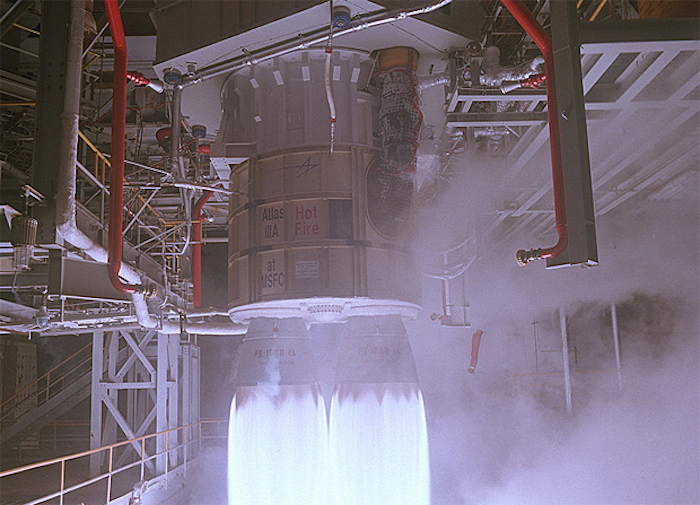
A Russian-built RD-180 engine during a test firing. NASA
-
But telemetry from the rocket, relayed via NASA television by ULA engineer Marty Malinowski, indicated the RD-180 shut down between five and seven seconds early. The Aerojet Rocketdyne RL10C engine powering the Centaur second stage then ignited for what was expected to be a 13-minute 38-second "burn."
At about 17 minutes and 16 seconds into flight, Malinowski reported "about a minute remains in this first burn of Centaur," indicating he was expected a normal shutdown close to the pre-flight prediction.
A minute-and-a-half later -- nearly 40 seconds past the predicted shutdown time -- Malinowski reported the "Centaur continues to perform very well." He finally called shutdown 19 minutes and 23 seconds after liftoff, about one minute and 14 seconds later than predicted.
"The team is evaluating the occurrence as part of the standard post-flight data analysis," according to a ULA statement released Thursday. "The Atlas 5's robust system design, software and vehicle margins enabled the successful outcome for this mission."
Asked about the apparent performance shortfall at a post-launch briefing, Vern Thorp, a senior ULA manager, called the ascent "pretty nominal" and indicated it was not unusual for actual burn times to differ from pre-launch predictions.
"The pre-launch predictions of exactly when the events are going to occur are based on a preliminary trajectory, typically it's been developed a few weeks before the launch," he said. "So it's not unusual for things to vary a little bit based on the actual conditions of launch.
"What I do know is that Centaur nailed the orbit, and like every mission, we're going to go do a very, very detailed post-flight review, we always do, always have done that, to make sure everything performed properly. From everything we've seen so far, the mission was pretty nominal."
But a discrepancy of more than a minute is unusual and, as ULA later confirmed, an "anomaly," one that left the Centaur without enough propellant to successfully drive the spent second stage into the atmosphere at the targeted re-entry point.
Instead, the stage re-entered farther downrange than expected, causing any surviving debris to fall outside of the predicted impact zone.
"The Centaur components that typically survive re-entry would have re-entered outside of the predicted landing location," a ULA spokeswoman confirmed. "The components that may have survived re-entry were predicted to come down in an uninhabited area of ocean east of the planned landing location."
Quelle: CBS
-
Update: 10.04.2016
.
Next Atlas V Launch Now Delayed Indefinitely
-
The United Launch Alliance (ULA) said very late yesterday that the launch of the next Atlas V rocket is now delayed indefinitely. ULA is investigating what went wrong on the launch of Orbital ATK's OA-6 Cygnus spacecraft on March 22.
Orbital ATK's OA-6 cargo mission to the International Space Station (ISS) was successful thanks to the Atlas V's Centaur upper stage, which was able to compensate for the under performance of the first stage. The first stage's RD-180 engine shut down 6 seconds early. The Centaur fired about one minute longer than planned to make up the difference in thrust needed to place Cygnus in the proper position for its ultimate rendezvous with ISS.
This was the first problem for the Atlas V in 62 launches.
ULA soon announced that it was delaying the next Atlas V launch -- of a military communications satellite, MUOS-5 -- for one week, from May 5 to May 12, while it investigated what happened. On March 31, the company said it had traced the anomaly to the first stage fuel system.
Late yesterday, ULA said in an emailed statement that the launch postponement is "indefinite:"
Cape Canaveral Air Force Station, Fla. (April 8, 2016) -- The Atlas V MUOS-5 launch is delayed and indefinite on the Eastern Range due to ongoing evaluation of the first stage anomaly experienced during the OA-6 mission. ULA successfully delivered the OA-6 Cygnus spacecraft to the International Space Station (ISS) on March 22. The MUOS-5 spacecraft and launch vehicle are secure at their processing facilities.
Somewhat ironically, ULA's announcement came shortly after a signature success by its competitor, SpaceX, which not only launched its own cargo mission to ISS, but landed the Falcon 9 first stage on a drone ship at sea.
Quelle: Space and Technology Policy Group
-
Update: 28.04.2016
.
ULA assembling Atlas V rocket at Cape Canaveral
-
United Launch Alliance has begun stacking its most powerful Atlas V rocket at Cape Canaveral Air Force Station while continuing to investigate the cause of last month's early shutdown by the rocket's main engine.
The company on Friday raised an Atlas V booster vertical on a stand inside the processing tower at Launch Complex 41.
This week it has begun strapping five solid rocket boosters to the first stage that will help propel a 7.5-ton Navy communications satellite from the launch pad.
No date has been announced yet for the launch of the fifth Mobile User Objective System satellite, or MUOS-5, which was once targeted for May 5.
---
SpaceX 'Red Dragon' capsules could launch to Mars by 2018
ULA put the mission on hold indefinitely following the March 22 launch of an Orbital ATK Cygnus spacecraft packed with International Space Station supplies.
During that flight, the Atlas V rocket’s Russian RD-180 main engine shut down six seconds too early, nearly jeopardizing the mission.
The Aerojet Rocketdyne RL10C engine powering the Centaur upper stage extended its burn by a minute to ensure a successful launch.
ULA has so far has said only that the main engine problem involved the “first stage fuel system and its associated components.”
The next launch will be the 63rd by an Atlas V, and the seventh of its most powerful version.
Quelle: FLORIDA TODAY
-
Update: 30.04.2016
Mixture ratio valve the culprit in Atlas 5 anomaly, next launch this summer

CAPE CANAVERAL — With the performance hit on the Atlas 5 rocket’s most recent flight last month now isolated to a faulty valve, preparations to resume the manifest are underway as United Launch Alliance workers stack the next booster for blastoff this summer.
The Mixture Ratio Control Valve (MRCV) governing the blend of RP-1 kerosene fuel and liquid oxygen flowing into the main engine of the Atlas 5 rocket “caused a reduction in fuel flow during the boost phase of the flight,” officials announced today.
During the March 22 launch, the first stage shut down six seconds early and the Centaur upper stage had to improvise by burning a minute longer to achieve the planned orbit.
The payload — Orbital ATK’s commercial Cygnus cargo freighter — successfully reached the proper orbit and did its rendezvous with the International Space Station to deliver over 7,000 pounds of supplies for the resident crew.
Engineers continue to evaluate the details surrounding the valve problem, and ULA is developing inspections for the Mixture Ratio Control Valve and actuator, expected to be complete in early May, to implement on the next vehicle.
“We observed nothing unusual in the mixture ratio commands until late in the first stage flight,” officials said.
FOD, or debris, impeding the valve’s operation has been ruled out as unlikely and non-credible.
The time to understand what caused the anomaly has delayed the next Atlas on the manifest from its original May 5 launch date until late June.
That upcoming rocket, designated AV-063, will launch the 15,000-pound mobile communications satellite, named MUOS No. 5, into space for the U.S. Navy.
Stacking of the vehicle began last Friday with the first stage being hoisted atop the mobile launch platform at the Vertical Integration Facility at Complex 41. The five solids were mounted this week and the Centaur upper stage will be added soon.
The payload will be installed a week before flight to complete the 206-foot-tall launcher.
Putting the first stage up vertically will allow additional inspections of the Mixture Ratio Control Valve and confirm associated components are ready for launch.
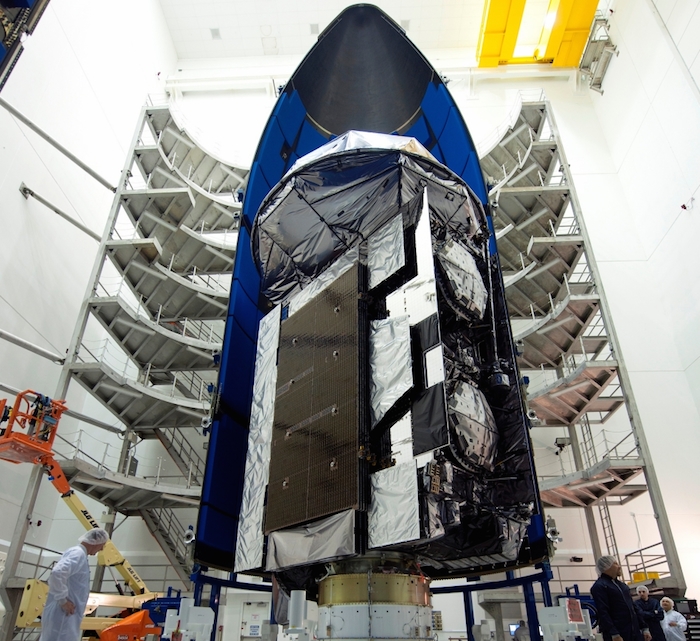
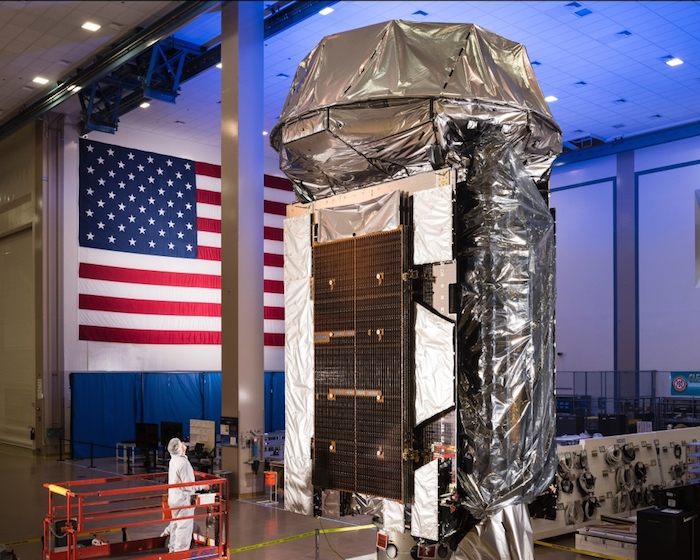
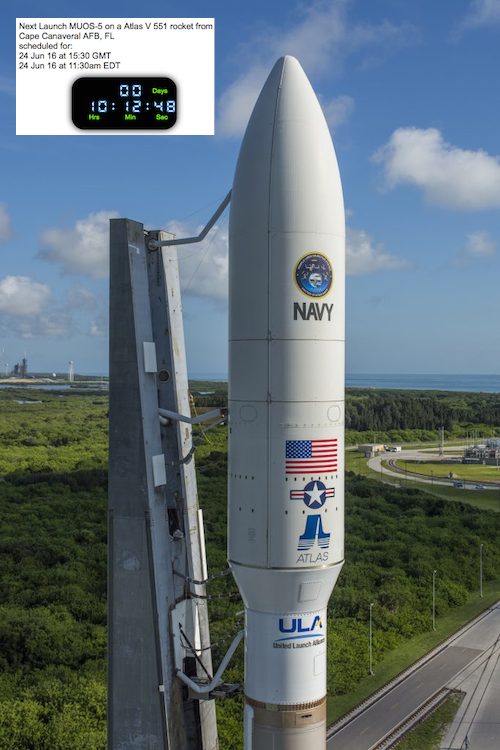
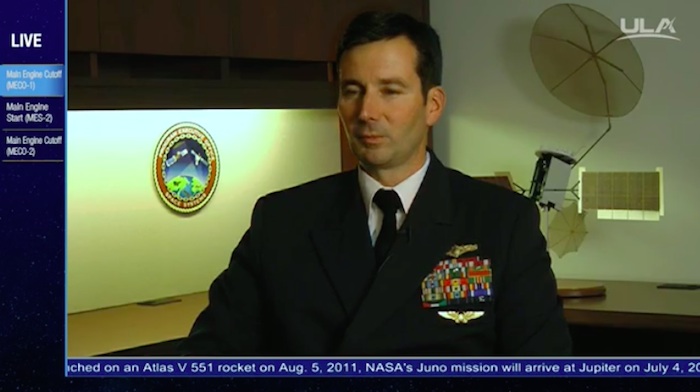


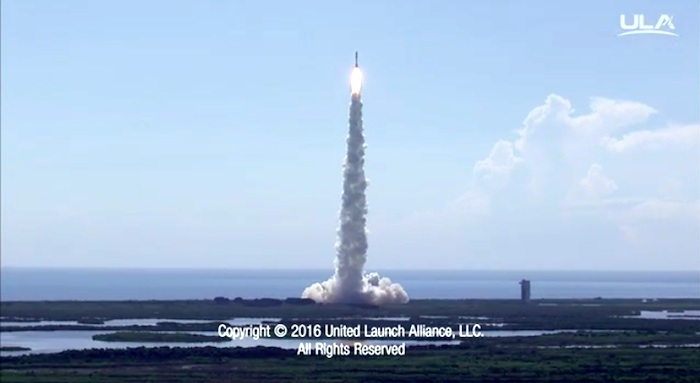


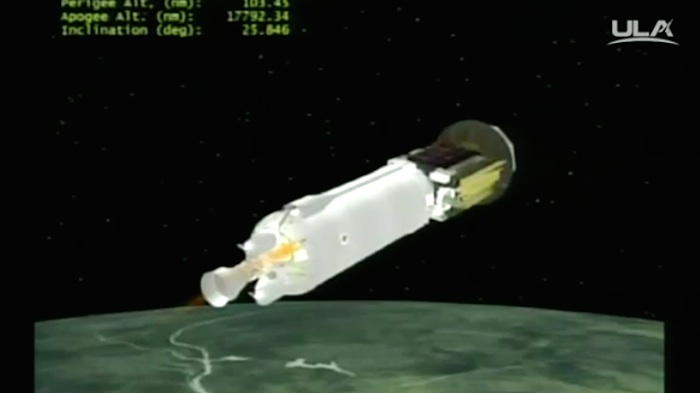
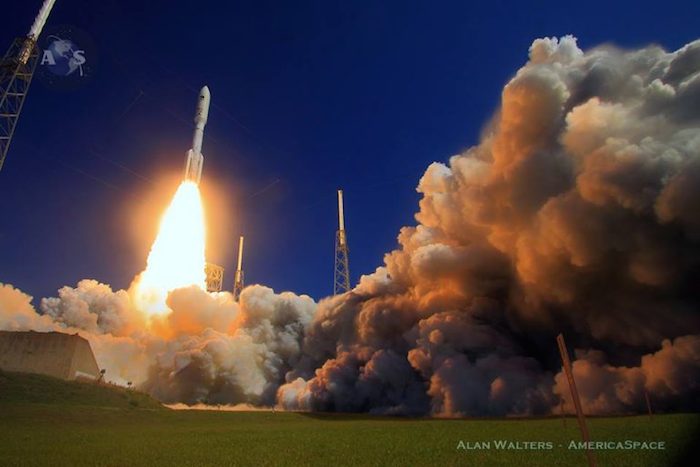
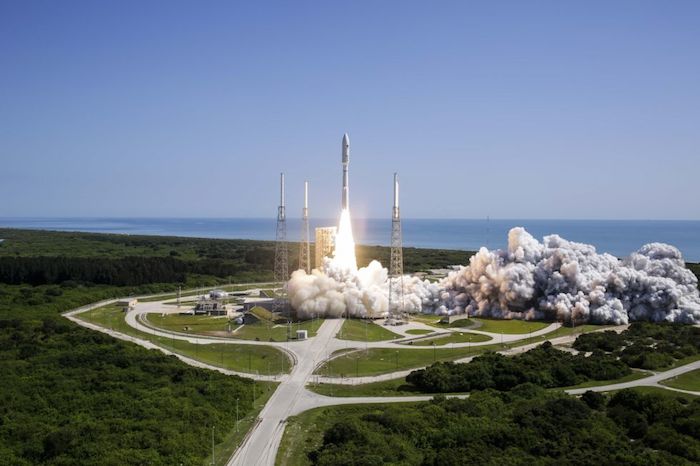

The launch will complete the planned globe-spanning constellation of five Mobile User Objective System spacecraft for a new voice, video and data relay network based on cellular telephone technology.
Built by Lockheed Martin, MUOS No. 5 will go into service providing legacy UHF communications to users in the Indian Ocean region and serve as an in-orbit spare for the Navy’s new “rugged smartphone” system.
Four previous MUOS satellites launched since 2012 by Atlas rockets — serving the Pacific, U.S., Atlantic and Indian Oceans — form the worldwide cellular phone network.
MUOS No. 5 will be capable of relocating itself within the geosynchronous belt to replace any of its four sister-satellites if ever needed.
Getting the massive payload to the intended dropoff point — an elliptical orbit of 2,373 by 22,237 statute miles at 19.1 degrees inclination — requires the very powerful Atlas 5 rocket in its 551 configuration. That means a vehicle with five strap-on solid rocket boosters for a total liftoff thrust of two-and-a-half million pounds.
The Centaur upper stage will fire three different times to heave the payload ever higher in the three-hour ascent.
The Atlas 5 schedule continues to show all 8 additional launches planned this year despite the MUOS delay, including the time-sensitive departure of NASA’s OSIRIS-REx asteroid sample-return expedition on Sept. 8.
MUOS 5 and a classified deployment for the National Reconnaissance Office are planned this summer, followed by OSIRIS-REx and a commercial Earth-imaging satellite in September, launch of a missile-warning satellite for the Air Force, a next-generation civilian weather satellite, a commercial broadband Internet-from-space craft and another NRO mission at year’s end.
United Launch Alliance’s next launch will be the Delta 4-Heavy on June 4, some time between 2 and 7 p.m. EDT (1800-2300 GMT), to deploy the National Reconnaissance Office’s NROL-37 spy satellite mission.
Quelle: SN
.
Update: 15.06.2016
.
Ready to Go: Lockheed Martin-Built MUOS-5 Secure Communications Satellite Encapsulated for June 24 Launch

MUOS-5 Completes Constellation for U.S. Navy’s New Network
Photo courtesy of United Launch Alliance
-
CAPE CANAVERAL AIR FORCE STATION, Fla., June 8, 2016 – The fifth Mobile User Objective System (MUOS) satellite built by Lockheed Martin (NYSE: LMT) for the U.S. Navy was encapsulated in its protective launch vehicle fairing on June 4. It is scheduled to launch June 24 aboard a United Launch Alliance Atlas V rocket.
Click here to download MUOS-5 satellite images.
MUOS-5 is the latest addition to a network of orbiting satellites and relay ground stations that is revolutionizing secure communications for mobile military forces. Users with MUOS terminals will be able to seamlessly connect beyond line-of-sight around the world and into the Global Information Grid. MUOS’ capabilities include simultaneous, crystal-clear voice, video and mission data over a secure high-speed Internet Protocol-based system.
“Like its predecessors, MUOS-5 has two payloads to support both these new Wideband Code Division Multiple Access (WCDMA) waveform capabilities, as well as the legacy Ultra High Frequency (UHF) satellite system, used by many mobile forces today,” said Mark Woempner, program director of Lockheed Martin’s Narrowband Communications mission area. “On orbit, MUOS-5 will augment the constellation as a WCDMA spare, while actively supporting the legacy UHF system.”
The MUOS-5 satellite joins four MUOS satellites already on orbit and four operational ground stations, providing near-global coverage including communications deep into polar regions. More than 55,000 currently fielded radio terminals can be upgraded to be MUOS-compatible, with many of them requiring just a software upgrade.
Once fully operational, MUOS will provide users with 16 times more communications capacity than the legacy system it will eventually replace.
Lockheed Martin manufactured MUOS-5 at its Sunnyvale, California facility. In March, the satellite shipped to the Cape, where it was pre-launch processed and finally encapsulated at Astrotech Space Operations, a wholly owned subsidiary of Lockheed Martin.
The Navy's Program Executive Office for Space Systems and its Communications Satellite Program Office, San Diego, California, are responsible for the MUOS program.
Quelle: Lockheed Martin
-
Update: 22.06.2016
.
Nice forecast for Friday Atlas V launch
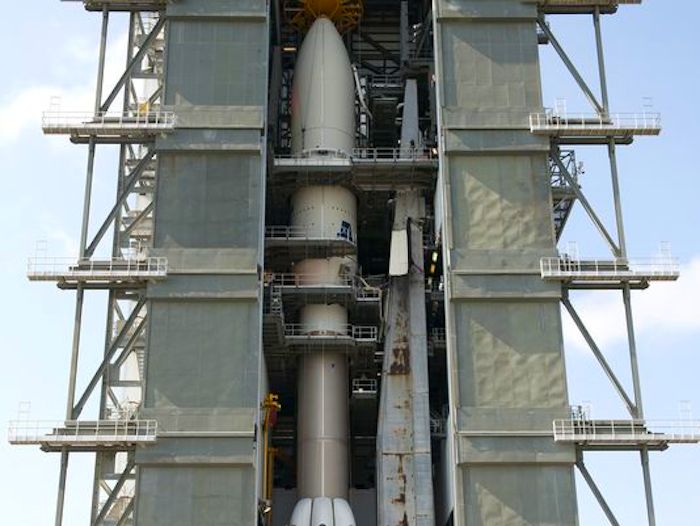
The MUOS-5 satellite was lifted and mated to a United Launch Alliance Atlas V rocket at Cape Canaveral Air Force Station's Launch Complex 41. Launch is targeted for 10:30 a.m. Friday. ULA
-
The forecast looks promising for a Friday morning launch of United Launch Alliance’s most powerful Atlas V rocket from Cape Canaveral Air Force Station.
There’s an 80 percent chance of acceptable weather for the planned 10:30 a.m. liftoff, at the opening of a 44-minute window at Launch Complex 41.
Thunderstorms are expected after later in the day, but there’s only a small chance that cumulus clouds could get in the way of a launch.
The Atlas V, with five solid rocket motors strapped to its booster, is scheduled to roll out of its processing tower to the launch pad Thursday morning.
Atop the 206-foot rocket is the Navy’s fifth Mobile User Objective System satellite, or MUOS-5.
The 15,000-pound satellite will support a critical communications link armed forces rely upon when on the move or in harm’s way.
It will also serve as a spare to a four-satellite constellation that promises more advanced, smart phone-like features once ground radios are upgraded over the next year or two.
ULA is launching its first Atlas V since March, when the rocket's main engine shut down six seconds early. The company says it has fixed a valve problem believed to have kept fuel from flowing properly.
Quelle: Florida Today
-
Update: 23.06.2016
.
Count Down: U.S. Navy, Lockheed Martin to Launch MUOS-5 Secure Communications Satellite June 24

The MUOS-5 satellite will complete the U.S. Navy’s Mobile User Objective System (MUOS) secure communications network once it is launched from Cape Canaveral Air Force Station, Florida, between 10:30 a.m. and 11:14 a.m. EDT on Friday, June 24.
-
CAPE CANAVERAL AIR FORCE STATION, Fla., The U.S. Navy and Lockheed Martin (NYSE: LMT) are ready to launch the fifth Mobile User Objective System (MUOS) secure communications satellite, MUOS-5, here on Friday, June 24, aboard a United Launch Alliance Atlas V rocket. The launch window is between 10:30 a.m. and 11:14 a.m. EDT.
Californians may be particularly interested in the Florida launch of the MUOS-5 satellite. The Navy's Program Executive Office for Space Systems and its Communications Satellite Program Office responsible for the MUOS program are based in San Diego. Lockheed Martin assembled and tested all five MUOS satellites at its Sunnyvale, California facility.
For the Navy, MUOS-5 completes a network of orbiting satellites and relay ground stations that is revolutionizing secure communications for mobile military forces. Users with MUOS terminals will be able to seamlessly connect beyond line-of-sight around the world and into the Global Information Grid, as well as into the Defense Switching Network. MUOS’ capabilities include simultaneous, crystal-clear voice, video and mission data over a secure high-speed Internet Protocol-based system.
“Users of the legacy satellite communications system can ‘talk,’ but they are limited to conversations between users under the footprint of the same satellite,” explains Mark Woempner, director of Lockheed Martin’s Narrowband Communications Systems. “MUOS is a game-changer for our forces, establishing a global military cellular network through which they can reach out to each other – and exchange mission data – almost anywhere around the world.”
MUOS-5 joins a network of four already-on-orbit MUOS satellites and four operational relay ground stations, providing near-global coverage, including communications reach deep into polar regions.
Like its predecessors, the MUOS-5 satellite has two payloads to support both these new Wideband Code Division Multiple Access (WCDMA) waveform capabilities, as well as the legacy Ultra High Frequency (UHF) satellite system. MUOS-5 will augment the constellation as a WCDMA spare, while actively supporting the legacy UHF system, currently used by many mobile forces today.
Once fully operational, the MUOS network will provide users with 16 times more communications capacity than the legacy system it will eventually replace. More than 55,000 currently fielded radio terminals can be upgraded to be MUOS-compatible, with many of them requiring just a software upgrade.
Quelle: Lockheed Martin
-
Update: 24.06.2016 / 7.15 MESZ
-

Quelle: ULA
...
Update: 17.00 MESZ
.







Quelle: ULA
-
Update: 25.06.2016
.
United Launch Alliance Successfully Launches MUOS-5 Satellite for the U.S Air Force and U.S. Navy
MUOS-5 completes the five-satellite constellation and acts as an on-orbit spare
Cape Canaveral Air Force Station, Fla., (June 24, 2016) – A United Launch Alliance (ULA) Atlas V rocket successfully launched the MUOS-5 satellite for the U.S. Navy. The rocket lifted off from Space Launch Complex-41 June 24 at 10:30 a.m. EDT.
MUOS-5 is the final satellite in the five-satellite constellation, which provides warfighters with significantly improved and assured communications worldwide.
“We are honored to deliver the final satellite in the MUOS constellation for the U.S. Navy,” said Laura Maginnis, ULA vice president, Custom Services. “Congratulations to our navy, air force and Lockheed Martin mission partners on yet another successful launch that provides our warfighters with enhanced communications capabilities to safely and effectively conduct their missions around the globe.”
The mission was ULA’s fifth launch in 2016 and 108th launch since the company formed in 2006. MUOS-5 was the seventh mission to be launched aboard an Atlas V Evolved Expendable Launch Vehicle (EELV) 551 configuration vehicle, which includes a 5-meter diameter payload fairing and five solid rocket boosters. The Atlas booster for this mission was powered by the RD AMROSS RD-180 engine and the Centaur upper stage was powered by the Aerojet Rocketdyne RL10C-1 engine.
“I am so proud of the team for all their hard work and commitment to 100 percent mission success,” Maginnis said. “It is amazing to deliver our second national security payload from the Cape in just two weeks. I know this success is due to our amazing people who make the remarkable look routine.”
ULA's next launch is the Atlas V NROL-61 mission for the National Reconnaissance Office, scheduled for July 28 from Space Launch Complex-41 at Cape Canaveral Air Force Station, Florida.
The EELV program was established by the U.S. Air Force to provide assured access to space for Department of Defense and other government payloads. The commercially developed EELV program supports the full range of government mission requirements, while delivering on schedule and providing significant cost savings over the heritage launch systems.
With more than a century of combined heritage, United Launch Alliance is the nation’s most experienced and reliable launch service provider. ULA has successfully delivered more than 100 satellites to orbit that provide critical capabilities for troops in the field, aid meteorologists in tracking severe weather, enable personal device-based GPS navigation and unlock the mysteries of our solar system.
Quelle: ULA
-
Update: 26.06.2016
-
Rückblick...
.



Quelle: ULA
5094 Views
